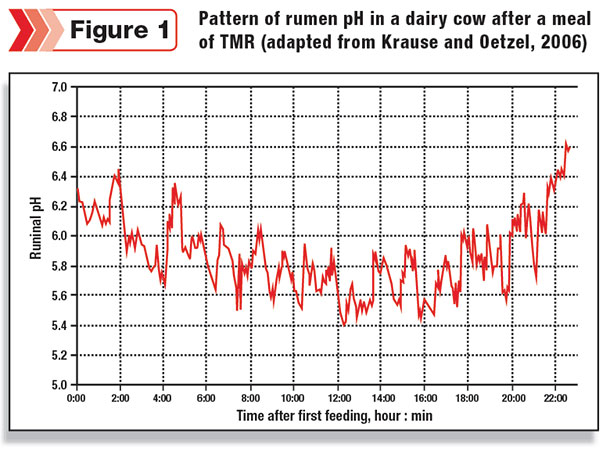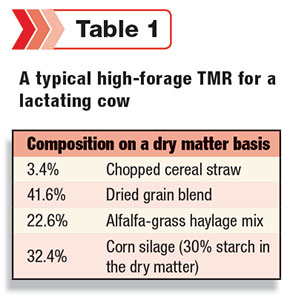Advances in forage genetics, harvesting, ensiling, management practices and forage analysis – in addition to dynamic ration balancing software – have allowed dairy farms to progressively feed increasing amounts of forage to their lactating cows. High-forage, lactating cow rations are typically defined as those containing more than 55 percent forage in the TMR or more than 25 percent forage neutral-detergent fiber (NDF) on a dry matter (DM) basis.
It is common for these TMRs to contain two-thirds of their forage DM from corn silage, either BMR, conventional or a combination of the two types of hybrids. It is often mistakenly believed that such rations will not expose the lactating herd to subacute ruminal acidosis (SARA). This can prove to be a costly misconception for the cow’s rumen function, and consequently milk yield and components.
Defining SARA
SARA is defined as the period of time the rumen pH stays below the cut-off point of pH 5.8. This threshold was selected to acknowledge the negative effect that a lowered pH has on ruminal cellulolytic bacterial activity and fiber digestion.
After the cow has eaten a meal, if the subsequent volatile fatty acids’ (VFA’s) production exceeds the capacity of the rumen to absorb, or buffer, the VFAs produced, the rumen pH will fall from its optimum of 6 to 6.5.
Since lactating dairy cows consume multiple meals (six to 10 per 24 hours), the rumen pH can and will vary throughout the day. A cyclical pattern of rumen pH does occur, and SARA is an occupational hazard for the modern lactating dairy cow ( Figure 1 ).

More recent trials have confirmed the multiple bouts of SARA within a day, and the number of daily combined hours the rumen environment was exposed to SARA ranges from 6.4 to 11.8 hours over three days.
High-forage TMR
In recent years, there has been a move toward diets that contain higher levels of forage. This strategy can reduce the need for the dairy to purchase feed and, when the forage quality is high, promote milk component yield. However, the majority of forage in such high-forage TMRs is corn silage.
What makes corn silage unique is that it is a combination of kernel-processed corn grain along with chopped corn stover. On a whole-plant corn silage DM basis, corn silage with 30 percent starch content typically contains 40 to 45 percent of kernel-processed corn grain and 55 to 60 percent chopped corn stover.
For every 1 pound of good-quality corn silage fed in a lactating cow ration, on a DM basis it is really like feeding four-tenths of a pound of kernel-processed high-moisture shell corn along with six-tenths of a pound of corn plant stover. In some ways, corn silage is like high-moisture shell corn on a stick.
The formulated ration in Table 1 has a 25.6 percent forage-NDF along with 58.4 percent forage content (chopped straw + haylage + corn silage) on a DM basis. However, the corn silage fraction at 30 percent starch will contain 40 percent of its dry matter in the form of kernel-processed high-moisture shell corn equivalent.

So this 32.4 percent corn silage inclusion really correlates to 12.9 percent kernel-processed high-moisture shell corn (32.4 x 0.4) and 19.5 percent chopped corn stover (32.4 x 0.6).
Therefore, the cow’s rumen will respond to two grain fractions in this “high-forage TMR” – the 41.6 percent dry grain blend plus the 12.9 percent kernel-processed high-moisture shell corn equivalent from the corn silage, or 54.5 percent grain equivalent in total, on a DM basis.
On paper, this appears to be 58.4 percent “forage” plus 41.6 percent grain TMR on a DM basis. In reality, the “hidden” kernel-processed high-moisture shell corn in the corn silage means the cow’s rumen will be responding to a 45.5 percent true forage component plus 54.5 percent total grain fraction.
These types of real-world situations mean SARA is still a real danger even with higher-forage-inclusion rations.
Consequences of SARA
Rumen wall epithelial cells are not protected by mucous and are vulnerable to damage by increasing VFA content and lower pH. Even on well-formulated and well-mixed TMRs, a cow’s rumen pH will vary throughout the day, reflecting her individual meal pattern ( Figure 1 ).
Within the rumen, this can lead to changes in the microbial populations and damage to the rumen wall, coupled with losses in milk production and feed efficiency.
The challenge is that individual cows do not necessarily show any immediate or overt signs of SARA. There may also be a time delay between the original SARA insult and any observable changes in milk production, behavior or health.
While the incidence of SARA is recognized as a herd syndrome, the risk for SARA within a herd is not the same for all cows. There is much variation in exposure to SARA within herds, even when cows are fed and managed similarly. Individual cow factors that can cause such variation include:
- Eating rate
- TMR sorting
- Salivation rate
- Individual cow ruminal microbiota
- Previous exposure to SARA
- Differences in VFA uptake at the rumen wall
This dairy cow individuality within a herd makes it nearly impossible to completely eliminate SARA from dairy herds. SARA is always present, and the aim is to minimize its effect and influence.
Dollars and cents of SARA
There are a number of inherent cow factors that will predispose fresh cows, early lactation, high-yielding and mid-lactation cows to SARA in any herd. This dilemma is further complicated by the wide array of on-farm feed and management factors that can exacerbate the daily inconsistencies and in turn increase the risks of SARA.
SARA is present on every dairy farm but often hard to identify. The hidden prevalence of SARA can be as high as 40 percent, and the cost to the U.S. dairy herd is estimated conservatively at $1.12 per cow daily. This cost primarily includes losses of milk yield and components, and would likely be greater if any health or fertility costs were included. PD
References omitted due to space but are available upon request. Click here to email an editor.
Tony Hall is with Lallemand Animal Nutrition’s technical services.

Tony Hall
Dairy Technical Service Manager
Lallemand Animal Nutrition
What does SARA look like?
On dairy farms, some of the physical observations that can be monitored – which may be directly or indirectly connected with SARA – are:
- Percentage of cows cud-chewing while resting
- Variable and bubbly feces
- Fecal color and loss of some ingredients in feces
- Cud spits in stalls
- Soil or concrete licking
- Excess free-choice sodium bicarbonate or salt intakes
- Low milk fat content or percentage of milk fat to milk protein inversions
- Laminitis challenges
- Poor appetite post-calving
- Incidence of LDAs
- Higher involuntary cull rates in the first 60 days postpartum
- Excess live-weight loss or negative body condition score changes in early lactation
- Declines in milk yield and feed efficiency





